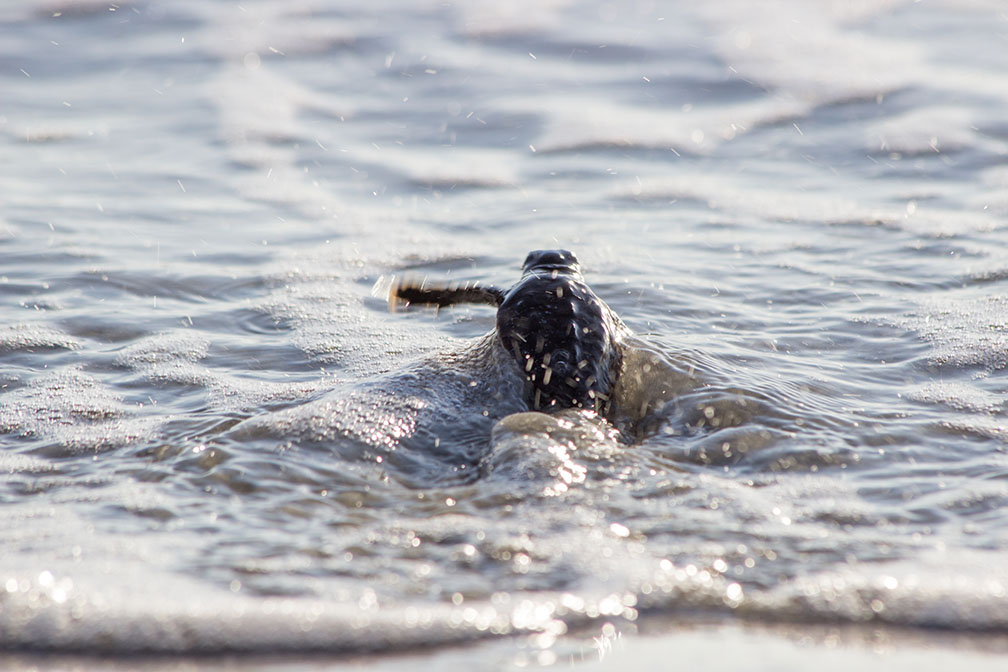In academia, climate change finds its way into many disciplines
By Dale White, dale.white@heraldtribune.com
While climate change and related sea level rise are still emerging priorities on the national and global consciousness, one of society’s most vital institutions — higher education — is already incorporating those daunting topics into its everyday thinking. Already on many campuses, with surely more to follow, getting a college education includes immersion into facts and predictions about how climate change could affect the near and distant future, and not just for students enrolled in subjects such as geology or meteorology.
Architects, civil engineers, city planners and other professions are likely to be affected in ways they have not experienced before.
As upcoming generations address the challenges associated with warmer temperatures and vanishing shorelines, academia must not only familiarize itself with the subject matter on a variety of levels but prepare students for a range of career opportunities that will require new skills yet to be fully defined, fine-tuned and taught.
Lynn Pasquerella, president of the Washington, D.C.-based Association of American Colleges and Universities, said she is seeing more of its 1,400 members — which include historic black colleges, two-year community colleges and major universities — incorporate climate change into their curricula.
Academia has a responsibility “to ask students to grapple with real-world global problems and this is certainly one of the most urgent,” Pasquerella said. Students need to be taught “to look at these issues from multiple perspectives” and faculty must make sure they are connecting what they teach with what those students need to know for their careers.
“Climate change is studied by college students in courses offered by an increasingly broad range of academic programs,” said Neil Leary, founding director of the Center for Sustainability Education. With support from NASA, the program based at Dickinson College in Carlisle, Pennsylvania, has instructed faculty from more than 60 colleges and universities nationwide about how to teach climate change on the undergraduate level.
“The motivation is a recognition that climate change, its causes, risks and solutions are relevant to all our students, whatever their chosen areas of study and future vocations,” Leary said. The study of climate change “has expanded far beyond courses in earth and environmental sciences at U.S. colleges and universities and into other sciences, social sciences, the arts and humanities.”
“Climate change will impact virtually every profession, from architects to zoologists,” said Julian Dautremont-Smith, director of programs for the 900-member Association for the Advancement of Sustainability in Higher Education. “It is of particular relevance to those who are involved in the built environment — engineers, architects, planners, etc. — and others who depend on climate conditions — farmers — but it’s also essential for business leaders, health care professionals, educators and, of course, politicians.”
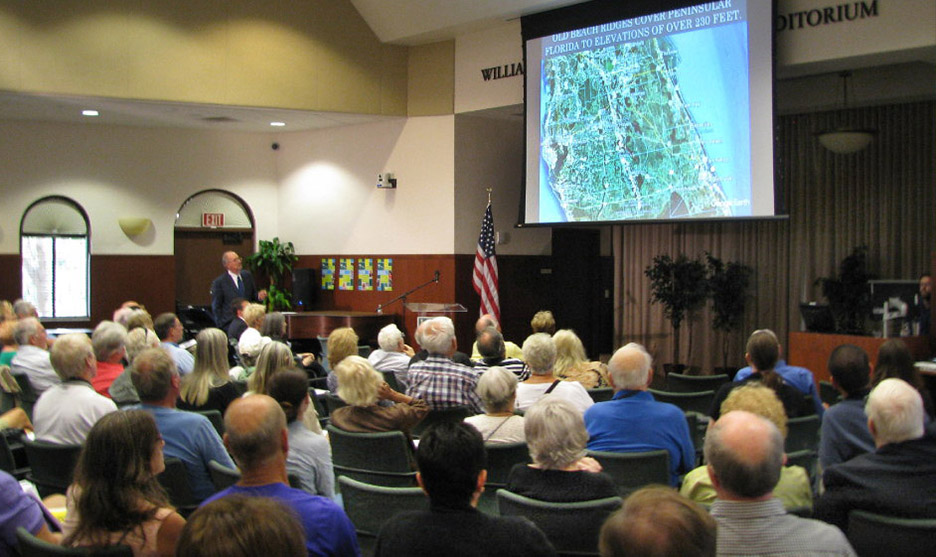
More employers will insist on hiring graduates with “sustainability competencies, even for jobs that aren’t explicitly focused on sustainability,” Dautremont-Smith predicted. “Moreover, the fastest growing segments of many industries are sustainability oriented — renewable energy, organic agriculture, green buildings and electric vehicles. The jobs of the future are sustainability jobs.”
With so much of the state’s population along its vulnerable coastlines, Florida’s public and private institutions of higher education are especially placing an emphasis on climate change on a broadening range of academic interests.
‘You are going to be affected’
At New College of Florida, the state’s honors college in Sarasota, several faculty members include climate change in courses pertaining to subjects that, on the surface, hardly seem associated with weather patterns — subjects ranging from anthropology to politics to urban design.
Anthony Andrews, an anthropology professor for more than 30 years, remembers encountering skepticism about climate change among his colleagues.
“Twenty years ago people weren’t interested,” Andrews said. “Nobody believed me. They said it was a natural cycle. ... When I started (teaching about climate change), I said, ‘Your grandkids are going to be affected by this.’ Then it was ‘your children are going to be affected by this.’ Now it’s: ‘You are going to be affected by this.’”
Andrews’ courses focus on human origins and “survivability,” the rise and fall of civilizations. His material spans from periods of ancient climate change — caused by shifting continents, volcanic eruptions and solar flares — to current climate change, which he says can be traced to extensive deforestation during the plantation era and the dawn of the industrial revolution and its smokestack industries.
“It’s happening a lot faster now” than in previous periods of global warming, Andrews said.
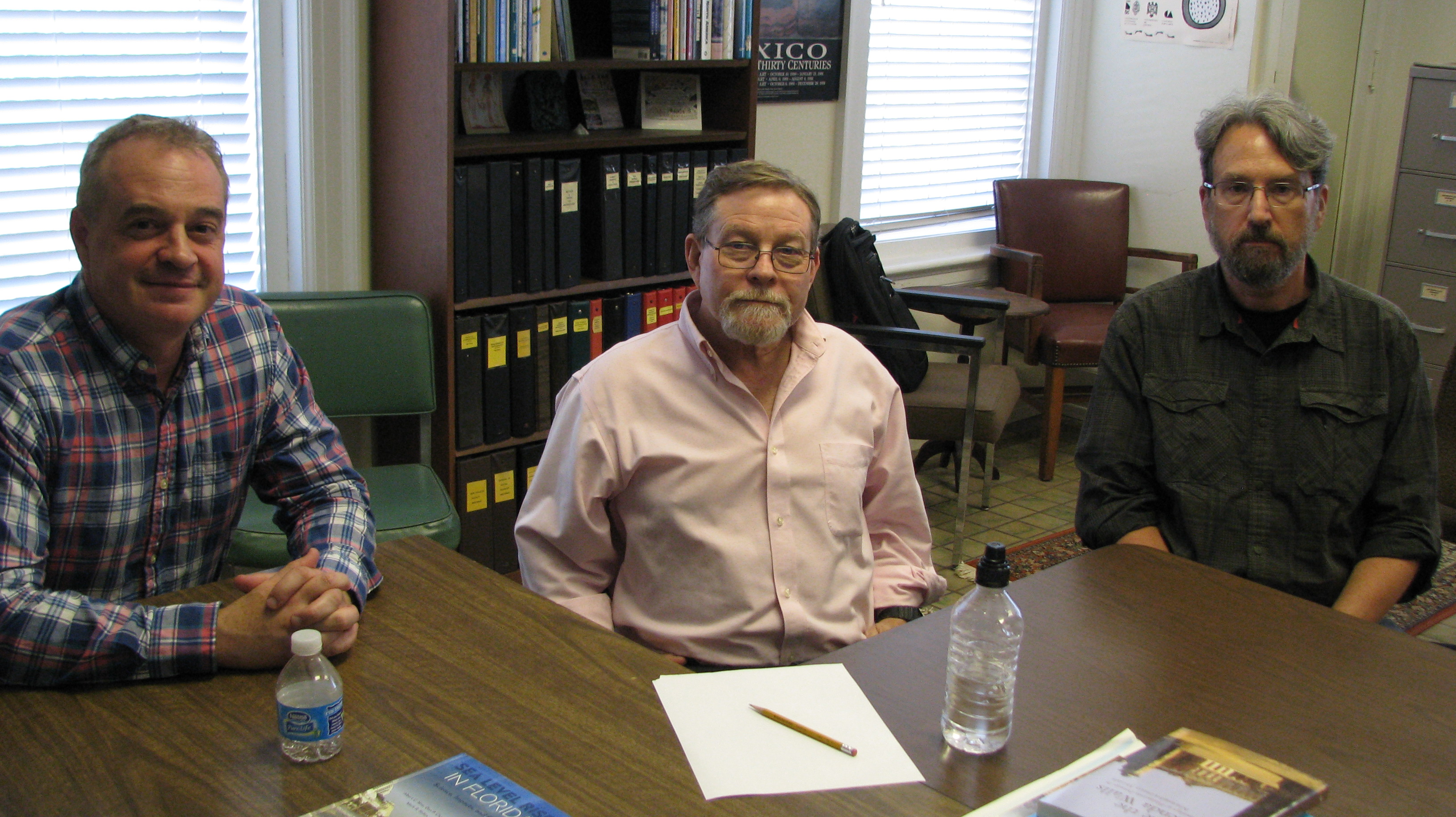
For about 10 years, Frank Alcock, associate professor of political science and environmental studies at New College, has integrated the topic into his curriculum. “Where have I not? It runs the gamut.”
Alcock strives not to be “advocacy oriented.” However, he wants his students to receive “a dose of reality without depressing them.”
He wants them, as potential political scientists and policymakers, to understand the “interplay between law and politics” and “what you have to navigate to put a policy into place,” to consider the possible ramifications of climate change on, for example, food and energy security.
Legal and political solutions are not as easy as students may presume, Alcock said.
For example, if local governments want to impose building moratoriums or compel waterfront property owners to relocate inland, they could be subjected to substantial litigation by those who contend their property rights are being violated and property values diminished.
Alcock’s students learn about Florida’s Bert Harris Private Property Rights Protection Act, which developers and others use to sue when a county or municipality dares to deny their land use plans. A tidal wave of litigation could affect local jurisdictions’ ability to even afford to brace themselves for whatever could be their exposure to climate change and its ramifications.
Thinking beyond ‘sustainability’
David Brain, professor of sociology and environmental studies at New College, has long taught about the concept of “sustainable cities.” He promotes walkable, transit-oriented development patterns that give residents options other than being so reliant on their cars.
“I thought we were making progress by 2008,” Brain said. After the recession, however, “people were just relieved to see people building again.”
Society is now back to “reproducing the same pattern” of developments, patchworks of suburban sprawl with one gated enclave next to another and another.
As he tries to convey what society should be doing to develop communities that are more efficient with their resources, Brain finds the term “sustainability” to be inadequate. “I ask: ‘How is your marriage working out?’ You say: ‘Well, it’s sustainable.’ That wouldn’t be good enough.”
Futurists and others speak of creating “zero carbon communities,” Brain said. However, he doubts people want to live as if on “a spaceship, an environment that has been dictated to you by pointy-headed engineers.”
His students are tasked with designing and redesigning communities that are not just sustainable but also desirable places to live.
Brain compares educating the public about climate change to the long and continuing effort to warn about health dangers associated with tobacco. Decades ago, cigarette manufacturers and even some physicians scoffed at the link between tobacco products and an array of diseases. Today, few deny that smoking is not only a dangerous but deadly habit.
Acceptance of climate change is reaching that turning point, Brain said. “I don’t have to convince the students that climate change is real. It’s in their peer culture.”
What Brain says he finds himself contending with is a “dismissive and elitist” attitude when students develop an “arrogant certainty in one’s opinions.”
When encountering skeptics about climate change or other hot-button topics they believe should be of paramount attention, they start “throwing out bombs,” Brain said. “They think the only way to change things is by being irritants.”
Brain teaches that “capitalism is not an unmitigated evil.” Those concerned about climate change can work within a capitalist society, he said. “You can make a difference without being revolutionaries.”
He urges students to watch televised meetings of city councils and county commissions and, as Alcock advises, become familiar with “what the law has to say.”
They can be instrumental in enacting change at the local level, if they do so in a constructive manner, Brain said. “You can show up (at a government meeting) with 10 of your friends and make a difference.”
Careers of the future
“I wish I were 20 again,” Harold Wanless, chairman of the University of Miami’s Department of Geological Sciences, told a packed audience when he recently lectured about climate change at the University of South Florida Sarasota-Manatee. “There are so many meaningful professions and critical opportunities to make a real global difference.”
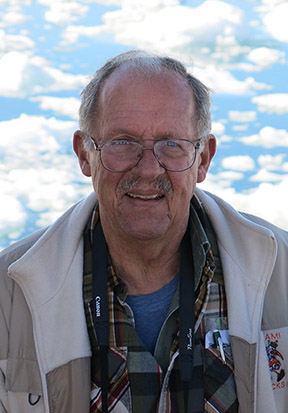
Wanless cites the diversity of career choices likely to be affected by society’s efforts to contend with sea level rise: architecture, law, security, infrastructure relocation and maintenance, ecosystems protection, maintaining food resources, humanitarian challenges.
Lynne McChristian, a faculty member at the Florida State University School of Risk Management and Insurance, adds the insurance industry to that expanding list.
To more precisely determine their risks and exposures, insurance companies will need to be on “the cutting edge of technology,” McChristian said. She expects college graduates to be seeing “more tech jobs in insurance. There is a great opportunity for analytics.”
At the University of West Florida, Haris Alibasic — who won national awards working in the field of climate change sustainability for the city of Grand Rapids, Michigan, and has spoken to international gatherings on the topic of sustainability at the local government level — shares his perspective at the graduate level in a public budgeting course and at the undergraduate level with a budgeting and finance class.
Alibasic has come to understand that the politics of climate change and sea level rise in the Florida Panhandle are different than they were in more liberal-minded Michigan but he’s getting a message out and he believes it has been well received.
“I get their different political perspective and they react very positively,” Alibasic said of his students. “They value the ability to discuss an issue that can potentially impact their community. ...
“I can educate them a lot about the issues related to the threat of climate change in discussions of public policy and adopting resilience,” he said. “You can really bring to light climate change by addressing the threats to infrastructure planning in the area.”
For instance, Alibasic, who holds a seat on the Climate Mitigation and Adaptation Task Force in Pensacola, said he talks to students about 24 rain events in the Gulf Breeze area that he has pinpointed as unusual in terms of their intensity. Discussion centers on real world issues such as handling stormwater runoff and maintaining and improving existing infrastructure.
He said climate change and sea level rise can also be incorporated into discussions about governmental ethics, the “moral responsibility” of cities and counties to address threats posed by a changing environment.
Realizing that Miami-Dade County is among the most vulnerable areas for coastal flooding, Florida International University established its Sea Level Solutions Center with a wide range of research missions — such as studying saltwater inundation in freshwater wetlands and evaluating the vulnerability of urban infrastructure.
The center’s purpose includes overseeing “interdisciplinary activities” to educate FIU students in fields such as architecture, engineering and ecology on climate change, Center Director Tiffany Troxler said.
“An interdisciplinary approach is absolutely fundamental to finding solutions” to climate change, she noted. “It’s such an integrated problem across so many disciplines. We need to leverage all of our collective resources.”

“Students can work collaboratively on design projects,” Troxler said. When doing so, they must consider “pushing the envelope.”
For example, FIU architecture and arts students created the exhibit “Miami 2100: Envisioning a Resilient Second Century” for the Coral Gables Museum. Using acrylic panels, toothpicks and other materials, they presented models of what metropolitan Southeast Florida could be like with higher sea levels at the turn of the century.
The exercise will make them conscious of what they must take into account when designing actual buildings and communities in coastal zones.
Sea level rise and the law
At the University of Florida, faculty and students are incorporating sea level rise into an array of studies.
“If you look across the university, this topic is being addressed from a range of perspectives — ecological, economic. UF is such a big university, we have people working on all facets of it,” said Mike Allen, director of UF’s Nature Coast Biological Station in Cedar Key.
The theme of this year’s Public Interest Environmental Conference at UF’s college of law is climate change. Several faculty members have focused on the legal impacts of sea level rise, held courses and clinics on it and have held multidisciplinary conferences with other UF colleges.

Law school professor Alyson Flournoy has written extensively about sea level rise. Among the issues she explores is how higher seas could wash away doctrines of beachside property rights on where private land ends and state submerged land begins and how that can affect public access.
“I’m making the case that courts really should take account of sea level rise if that is the context in which there is a boundary dispute. It may require them to look at the values that underlie the doctrines — one is fairness and the other is protecting the public interest,” Flournoy said. “I hope more and more coastal communities will be able to focus on (sea level rise) but educating citizens is critically important. ... That’s our goal — to provide something that is informed by what we know about law and policy on (sea level rise) and give people a primer.”
Fellow law professor Tom Ankersen was part of a team that taught a field course on sea level rise and coastal ecology. Several other faculty members have focused on sea level rise including on how potential regulations to help a local government adapt to it can impact private property rights.
Also diving into sea level rise is UF’s College of Design, Construction and Planning, which is creating the Florida Institute for Built Environment Resilience.
Professors for years have been researching sea level rise and have assisted communities as near as Cedar Key and St. Augustine and as distant as parts of Europe and Africa to try to determine potential impacts and develop adaptive measures.
Two professors at the college, Martha Kohen and Nancy Clark, last year joined with UNESCO — the United Nations Educational, Scientific and Cultural Organization — to stage a two-week international workshop on specific problems of sea level rise’s effects on urban buildings and infrastructure.
They have traveled globally to work on sea level rise projects. But Kohen said her initial interest happened locally when a group of students rebelled during a planning project for St. Augustine because it did not initially address sea level rise.
“From then on we started getting more and more requests from (communities) all along the coast. We traveled to Brazil to see how neighborhoods are addressing the issue,” Kohen said. “We did projects in (several Florida cities). We dare to do the projects of infrastructure on a big scale that needs to happen if we want to continue to inhabit these coastal areas.”
The college has also received funding from the National Oceanic and Atmospheric Administration and Sea Grant programs in multiple states.
Meanwhile, a collaboration between the college, the Tampa Bay Regional Planning Council and NOAA resulted in an online tool that will show impacts of sea level rise of varying feet in Tampa.
Ecosystems and food supplies
Bethune-Cookman University in Daytona Beach has added a variety of courses to its curriculum pertaining to climate change. On the ecosystems protection front, the institution launched a joint project with the NOAA’s Center for Coastal and Marine Ecosystems.
Professor J. Hyun Jung Cho has four students researching ocean and coastal environments. Their course work will include 12-week internships at NOAA, said Cho, a professor in the Department of Integrated Environmental Science. She also has three graduate students researching how “living shorelines” can help protect coastlines as sea levels rise.

UF is also working in the water.
Peter Frederick, a professor of wildlife ecology and conservation, has a $6.8 million grant from the National Fish and Wildlife Foundation to try to rebuild oyster reefs in the Big Bend region of the Gulf of Mexico.
The reefs have drastically declined over the years and so has the oyster industry. Frederick said the reefs have not declined because of sea level rise but added the absence of reefs creates more erosion as the gulf expands inland. That saltwater will reduce freshwater flow, which will impact the oysters, Frederick said.
“Oysters are one of the few things we know that can actually build structure and make things resilient to sea level rise,” Frederick said. “A healthy oyster reef can keep up with sea level rise. But if the shoreline behind it is dying back, that may change the nature of the coastline itself. ... If estuaries become more saline, it’s very bad news for oysters. As sea level rises it becomes harder to push freshwater and backs it up.”
A group of four students in Associate Professor Jason Evans’ landscape ecology class at Stetson University in DeLand visited several towns in coastal Georgia in late September to see firsthand the impacts of rising seas in the low-lying region.
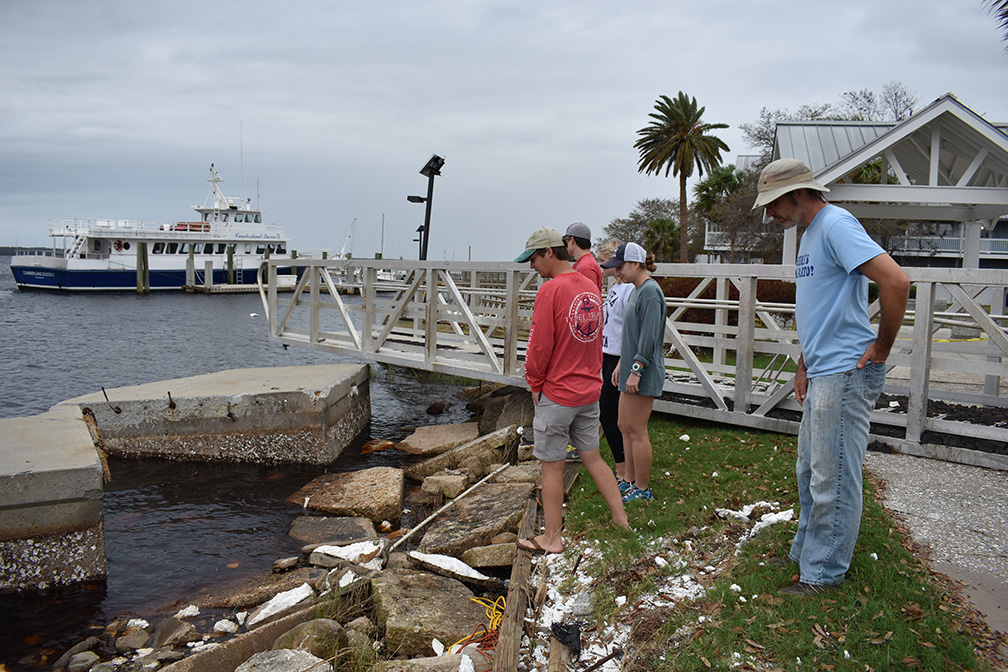
One stop was in St. Marys, where Evans has worked to help the city cope with stormwater trouble brought on by rising seas.
“If you want a good job and you’re interested in stormwater,” Evans told the students, it’s going to be one of the careers in high demand. “And there aren’t that many people going into it.”
Seniors Savannah Hardisky and Rachel Saunders said they expect to see more opportunities in fields related to addressing sea level rise. Saunders said her time at Stetson has shown her “the opportunities there are to make an impact to help mitigate sea level rise.”
Meanwhile, Stetson is also developing a curriculum for sustainable food systems.
“Food is one of those things we take for granted," Wendy Anderson, professor and chair of environmental science and studies, said. “But if you live in Puerto Rico right now you’re not taking it for granted. Your whole season of crops has been wiped out. That’s not just your food, it’s your financial situation.”
These conversations about complex problems also have been driving university research, she said. “We see a problem that needs to be addressed and we figure out how to develop a strategy to address it.”
If universities can get students to “grasp the challenge and start thinking in innovative and exciting new ways about how we can address the challenges that climate change poses,” such as food supplies, that’s where entrepreneurship and economic stimulus come in, Anderson noted.
“I think every potential career path has the likelihood of kind of reframing itself,” she said. “Any student that has a clear understanding of the changing environment and the way that their discipline impacts it, they’re going to have a leg up in their careers.”
“Students coming from the school of business, if they can understand the business opportunities, and helping an organization to understand the benefits of clean energy or switching to sustainable energy, they’ll be ahead of the curve when they’re looking for a job,” Anderson said. “Having students skilled in those complex decision-making processes and the planning and design skills, they get put to use in solving these particular kinds of problems.”
Brain, the sociology professor at New College, agrees that more professions will alter their thinking, priorities and methods as they adjust to climate change. Yet he thinks there are still many unknowns and that academia itself is still learning those new skillsets so it can pass them on to upcoming generations.
“We have a lot of work to do to create these receiving stations for students with these interests,” Brain said.
Many of the new ways of adapting so many professions to tackling challenges brought on by climate change may originate with the students themselves, Brain noted. “They can be creative in finding offbeat career paths.”
Dinah Voyles Pulver of the Daytona Beach News-Journal, Cindy Swirko of the Gainesville Sun and Tom Mclaughlin of the Northwest Florida Daily News contributed to this report.
